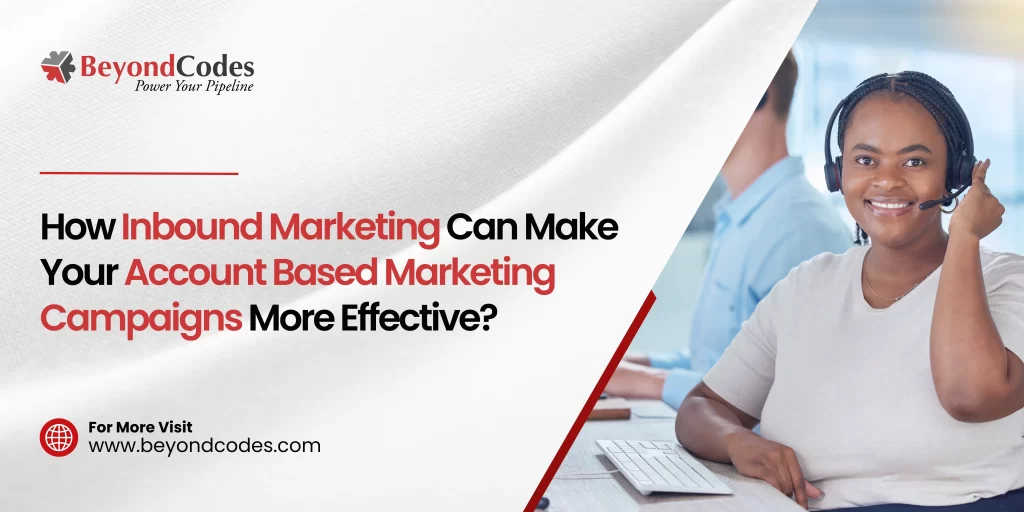Qualified leads are generated when you have an effective marketing strategy. B2B marketing is ever changing. Your buyer is evolving, so is marketing technology, new marketing strategies are coming up. Account-based marketing is one such marketing strategy that has gained considerable popularity in recent times such that a lot of B2B marketers are using it to get better results.
As a marketer, it is necessary to adopt the latest marketing trends but what makes a marketer successful is how one can blend the traditional approach and modern trends to build more effective marketing campaigns.
Account-based marketing can be made more impactful if you use the traditional inbound marketing with it as well. So, before we understand how we can use them together, let’s understand how different they are from each other.
ABM vs the Inbound Marketing Approach-
Account-based marketing leverages highly targeted, and personalized campaigns to convert specific accounts. Rather than targeting everyone in the market, ABM segments a narrow set of accounts and invests its resources in converting them into lifetime customers.
As a B2B marketer, you must have experienced that closing a deal doesn’t involve a single person. There are a lot of decision-makers involved. ABM differs from the inbound approach as it acknowledges all the decision-makers of the account and understands their viewpoints.
In inbound marketing, leads are attracted first through different marketing strategies, among the leads generated, the ones that qualify are then nurtured through different channels like email marketing to convert them into customers.
The reverse happens in account-based marketing, companies that need to be targeted are identified in the first stage itself, and through personalized campaigns, these accounts are nurtured, and once they are closed, building long term relationships with them becomes the prime focus.
So, rather than finding a target company at the end of the sales funnel after filtering out the bad accounts, ABM focuses on targeting the right accounts at the beginning of the sales funnel and actively pursues them with all the resources in hand to convert them into customers.
Benefits of Using Account-Based Marketing-
1. Better ROI-
As per an ITSMA survey, almost every B2B solution provider who measures account-based marketing found out that ABM gives a better ROI than other marketing tactics. Due to its highly precise nature, marketers can focus their resources on a few accounts, which leads to a higher probability of closing an account.
2. Proper alignment between sales and marketing-
Account-based marketing is primarily focused on specific accounts instead of getting leads. Due to this nature, marketing and sales communicate in the same language. As they must be on the same page to execute a successful ABM campaign, both the marketing and sales team get in proper sync with each other.
Most of the time, the reason why marketers and sales teams would have major differences is due to the kind of approach they both have towards work. Marketers mostly build campaigns around people belonging to different markets and industries, whereas sales professionals would mostly interact with accounts who would probably buy from them.
In ABM, marketers have to create highly personalized campaigns for targeted accounts and sales professionals have to interact with the same accounts. Also, ABM clears all the arguments regarding the quantity of leads and the quality of leads.
3. Better customer experiences-
Nobody likes generic content today; everyone wants content that is relevant to them and addresses their pain points. Today, in the era of content explosion, an average customer receives hundreds of marketing messages every day. Amidst this clutter, if you want your message to stand out, you need to make the message more personal. Since ABM involves targeting specific accounts, it requires personalized content offers that resonate with those accounts, making them engage with you.
4. Better use of resources-
ABM marketing strategies are highly focused and target specific accounts which in turn helps marketers to get more results from fewer resources as the accounts targeted are specifically optimized. Also, the marketing campaigns are mapped around these accounts, which maximizes the ROI.
Balancing the ABM and Traditional Inbound Approach-
Successful B2B marketers use both the approaches to leverage resources to their maximum potential and create the right impact. Syncing ABM and the traditional inbound marketing methods can help you give the right amount of focus to small but valuable accounts whereas through inbound marketing you can always cast your net across different niches and get relevant leads.
ABM is essential to close big accounts, but as an organization, one cannot be completely dependent on ABM. You need to keep using the traditional inbound marketing approach to find out relevant opportunities you aren’t possibly targeting. The key is to allocate the right amount of time and money to each marketing strategy. If you can do that, be it ABM or inbound marketing, you will excel in both.







